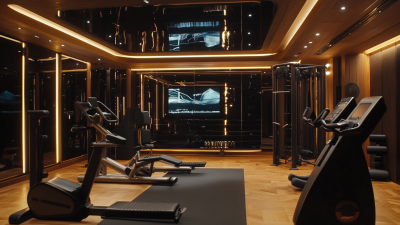Exploring the Future of Exercise Equipment at the 138th Canton Fair 2025: Industry Trends and Insights
As the fitness industry continues to evolve, the upcoming 138th Canton Fair in 2025 presents a significant opportunity for stakeholders to explore the latest advancements in exercise equipment. According to the Global Fitness Equipment Market report, the market is projected to reach $15 billion by 2025, reflecting a compound annual growth rate (CAGR) of 3.5% from 2020 to 2025. This surge in demand is driven by a growing awareness of health and wellness, an increasing trend towards home workouts, and the integration of smart technology in exercise equipment. At this prestigious event, industry leaders will showcase innovative solutions that cater to various consumer needs, emphasizing sustainability, digital connectivity, and personalized fitness experiences. By engaging with emerging trends and insights from the fair, participants can better navigate the dynamic landscape of exercise equipment, ultimately shaping the future of fitness.

Innovations in Home Fitness Equipment Showcased at the 138th Canton Fair
At the 138th Canton Fair in 2025, the spotlight shines on innovations in home fitness equipment, showcasing how technology is shaping the future of personal health and wellness. The global home fitness equipment market, valued at approximately $10 billion in 2023, is expected to grow at a compound annual growth rate (CAGR) of over 7% during 2024-2028. This growth is driven by increased consumer interest in health, convenience, and the latest advancements in smart technology.
Exhibitors at the fair present a range of cutting-edge products, including AI-powered fitness machines and interactive training platforms that cater to various fitness levels and preferences. For instance, the use of virtual reality in workout routines is gaining traction, with reports indicating that VR fitness experiences can boost engagement by 40% compared to traditional workouts. Additionally, the surge in compact and versatile workout equipment, designed for limited living spaces, reflects a larger trend where 60% of fitness enthusiasts prefer home workouts due to flexibility and accessibility. These innovations not only enhance user experience but also create a robust ecosystem that promotes healthier lifestyles.

Emerging Trends in Smart Fitness Technologies for 2025
At the upcoming 138th Canton Fair in 2025, the spotlight will be on the burgeoning field of
smart fitness technologies, which are set to revolutionize the way we approach exercise and wellness.
As consumers increasingly demand more interactive and personalized workout experiences, companies are innovating equipment that integrates advanced technology.
One of the key features of this emerging trend is the integration of AI-driven coaching systems. These systems can analyze user performance in real-time,
providing tailored feedback and workout plans that adapt to individual fitness levels and goals.
Moreover, the rise of connected fitness equipment is transforming home workouts into a more social and engaging experience.
Products featuring built-in connectivity allow users to join live classes, compete with friends, or even engage with online fitness communities.
This connectivity extends to health monitoring capabilities, with many devices now incorporating wearable technology to track vital metrics such as heart rate and calories burned.
As these smart fitness solutions continue to evolve, we anticipate even greater innovations that will not only enhance user engagement but also promote healthier lifestyles in
2025 and beyond.
Sustainable Practices in Exercise Equipment Manufacturing
At the 138th Canton Fair in 2025, the future of exercise equipment is poised to be heavily influenced by sustainable practices in manufacturing. A recent industry report by Allied Market Research highlights that the global fitness equipment market is projected to reach $15 billion by 2027, with an increasing focus on eco-friendly production methods. Manufacturers are prioritizing the use of recycled materials and energy-efficient processes to reduce their carbon footprint, aligning with the growing consumer demand for environmentally responsible products.
Additionally, according to a study by Research and Markets, approximately 60% of consumers are willing to pay a premium for sustainable fitness equipment. This shift in consumer behavior is driving companies to innovate and explore materials such as bamboo, recycled plastics, and biodegradable composites. As the industry evolves, we are likely to see cutting-edge designs that not only enhance functionality but also minimize environmental impact, paving the way for a greener fitness future that resonates with health-conscious and eco-aware consumers alike.

Market Analysis: Consumer Preferences in Fitness Equipment
As the fitness equipment market evolves, consumer preferences increasingly shape industry trends. Notably, the global market for fitness-related products, including exercise equipment, has demonstrated substantial growth, with expected annual increases in various segments. For instance, the market for wireless headphones, a popular accessory among fitness enthusiasts, is projected to rise from $73.98 million in 2025 to over $128.256 million by 2033, reflecting a compound annual growth rate of 7.12%. This growth is indicative of a broader trend where convenience and technology integration play pivotal roles in consumer choices.
Moreover, the segment of massage devices, particularly for the feet and legs, shows promising expansion, anticipated to grow from $61.8 million in 2025 to approximately $95.9 million by 2032. The rise in demand for recovery and relaxation tools among consumers post-exercise underscores a shift in fitness culture, where holistic wellness approaches are increasingly valued. Each emerging trend highlights the dynamic nature of consumer preferences within the fitness equipment market, pointing towards a future where innovation and personalization will further drive growth and engagement in this sector.
Future of Connected Fitness: Integrating IoT in Exercise Gear
The 138th Canton Fair in 2025 promises to be a pivotal event for the exercise equipment industry, highlighting the future of connected fitness through the integration of the Internet of Things (IoT) in workout gear. As consumers increasingly seek personalized fitness solutions, manufacturers are leveraging IoT technology to create equipment that not only tracks performance metrics but also communicates seamlessly with other devices. This integration allows users to access real-time data, set goals, and adjust their workouts based on comprehensive insights that were previously unattainable.
Moreover, the rise of smart exercise equipment is revolutionizing how individuals engage with fitness regimens. Devices equipped with IoT capabilities can provide tailored feedback, suggest workout modifications, and even connect users with trainers for virtual coaching sessions. The 138th Canton Fair will showcase innovations ranging from smart weights to interactive fitness mirrors that utilize IoT to enhance user experience, ensuring that the future of exercise equipment is not only about physical strength but also about smart, connected living. As these trends continue to evolve, they will undeniably shape the landscape of fitness, making it more accessible and engaging for everyone.
Exploring the Future of Exercise Equipment at the 138th Canton Fair 2025: Industry Trends and Insights - Future of Connected Fitness: Integrating IoT in Exercise Gear
| Category | Trend | Insights | Future Potential |
|---|---|---|---|
| Smart Wearables | Integration with Health Apps | Wearables are increasingly connecting with health tracking apps to provide users with a comprehensive fitness overview. | High; as consumer interest in personal health grows. |
| Connected Equipment | Real-time Data Analytics | Fitness machines will offer real-time feedback, improving workout efficiency and personalizing training. | Moderate; dependent on consumer adoption. |
| Virtual Fitness | Augmented Reality Workouts | AR technology may enhance user engagement by creating immersive workout experiences. | Very high; as technology advances and prices decline. |
| Home Gym Equipment | Compact and Multi-functional Gear | Demand for space-saving equipment is rising, focusing on versatility for at-home workouts. | High; trend toward remote workouts persists post-pandemic. |
| Sustainability | Eco-friendly Materials | Sustainability is becoming a priority, with a push for durable, recyclable exercise gear. | Growing; as consumers become more environmentally conscious. |
Related Posts
-

What is the Future of Home Gym Equipment for Global Buyers
-

Championing Global Fitness with China's Leading Best Exercise Equipment Manufacturing Power
-

The Future of Home Gym Equipment Revolutionizing Fitness With Smart Technology
-

7 Essential Insights for Global Buyers of Exercise Equipment
-

Exploring the Versatility of Exercise Equipment: Features, Benefits, and Ideal Use Cases
-

Future of Workout Equipment Innovations for 2025 and Beyond Guide
